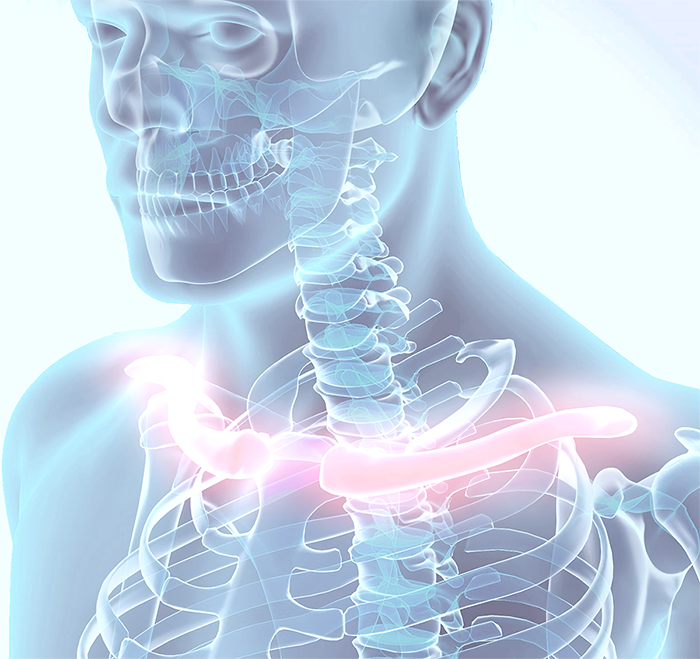What is a Clavicle Fracture?
 A clavicle fracture occurs when there is a break in the collarbone. And the collarbone is one of the main bones in the shoulder. Clavicle fractures are very common and they account for about 5 percent of all fractures in adults. Sometimes, this injury happens from a fall on the shoulder. Or, even an outstretched arm when a fall occurs could cause a broken collarbone. In fact, a broken collarbone is extremely painful, and it often creates difficulty with the arm motion.
A clavicle fracture occurs when there is a break in the collarbone. And the collarbone is one of the main bones in the shoulder. Clavicle fractures are very common and they account for about 5 percent of all fractures in adults. Sometimes, this injury happens from a fall on the shoulder. Or, even an outstretched arm when a fall occurs could cause a broken collarbone. In fact, a broken collarbone is extremely painful, and it often creates difficulty with the arm motion.
A broken collarbone is commonly treated with a sling. This is worn to keep the arm and shoulder from moving around for optimal healing. Sometimes, when a clavicle fracture occurs the pieces of bone will also slide out of place. Surgery is often required for more severe fractures that need collarbone realignment.
Symptoms of a Collarbone Fracture
When a clavicle fracture happens, it is 0ften very painful and difficult to move. Additional signs and symptoms of a fracture are as follows:
- Bruising, swelling, and/or tenderness over the collarbone
- Downward and forward sagging of the shoulder
- Unable to lift the arm due to pain
- A grinding sensation when you try to raise the arm
- A deformity or “bump” over the break
Causes of a Clavicle Fracture
It’s typical for a clavicle fracture to be caused by a direct blow to the shoulder. Often times this happens during a car collision or a fall. Additionally, a fall on an outstretched arm can also cause a broken collarbone. Sometimes, a clavicle fracture will also occur during birth to baby, when passing through the birth canal.
Broken Collarbone Treatment
First and foremost, conservative treatments are looked at. Although there are cases where surgery is required for a full recovery. However, if the broken ends of the bones are not severely shifted out of place, surgery might not be required.
Non-surgical methods include:
Medication
It’s a conservative method for medication to be used to relieve pain. In fact, acetaminophen is often used to help relieve pain.
Immobilization:
A simple arm sling is usually used for comfort immediately after the break and to keep your arm and shoulder in position while the injury heals. It is critical for proper healing to restrict the movement of a broken bone.
Physical Therapy:
Physical therapy is a good option. Rehab for your wrist is an important part of healing and can take several months. Often, patients will begin doing exercises for elbow motion immediately after the injury.
Surgical Treatment Options:
Depending on the severity, however, surgery might be required. If the broken ends of the bones have significantly shifted out of place, your doctor may recommend surgery. These might be options, such as:
Open reduction and internal fixation. This is the procedure most often used to treat clavicle fractures. During the procedure, the bone fragments are first repositioned (reduced) into their normal alignment. The pieces of bone are then held in place with special metal hardware.
Common methods of internal fixation include the following:
Plates and screws. After being repositioned into their normal alignment, the bone fragments are held in place with special screws and metal plates attached to the outer surface of the bone.
Pins or screws. Pins or screws can also be used to hold the fracture in a good position after the bone ends have been put back in place. The incisions for pin or screw placement are usually smaller than those used for plates.
Pain management. After surgery, you will feel some pain. This is a natural part of the healing process. Many patients find that using ice and simple, non-prescription medications for pain relief are all that is needed to relieve pain.
Rehabilitation. Specific exercises will help restore movement and strengthen your shoulder. Your doctor may provide you with a home therapy plan or suggest that you work with a physical therapist.
If you experienced a broken collarbone and are looking for relief, call us now at 888-409-8006. Schedule an appointment with our shoulder specialist.
